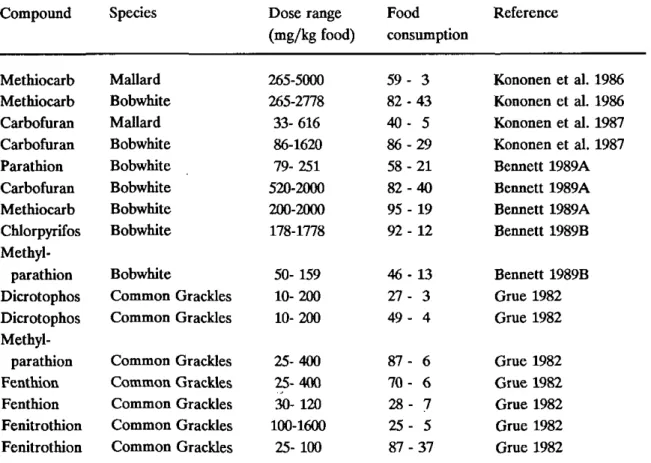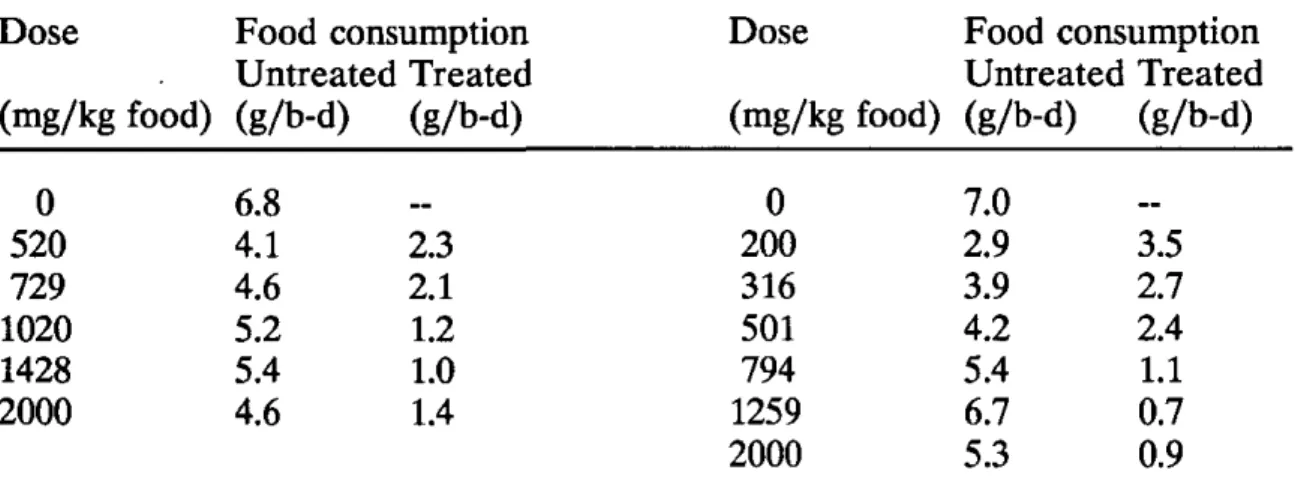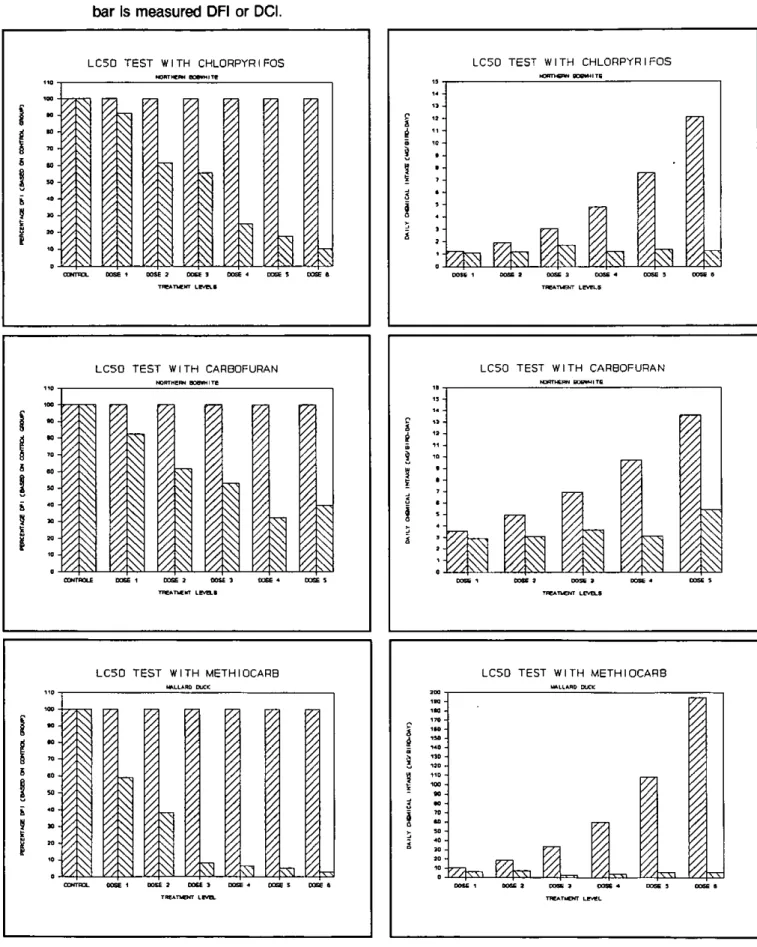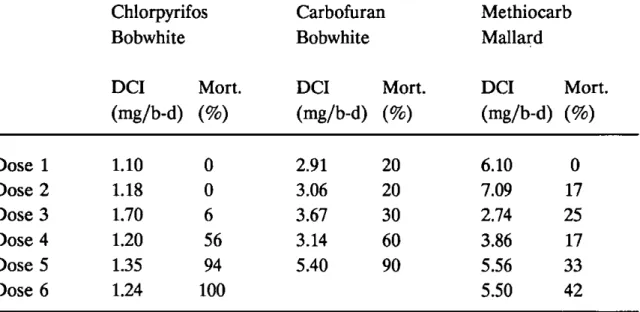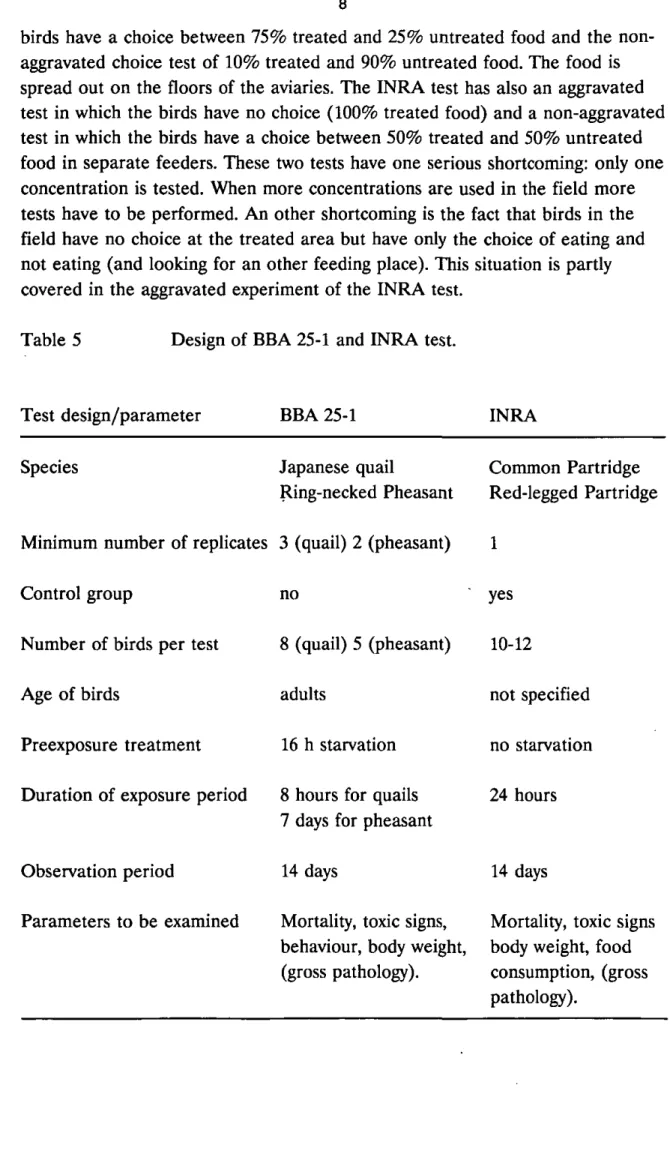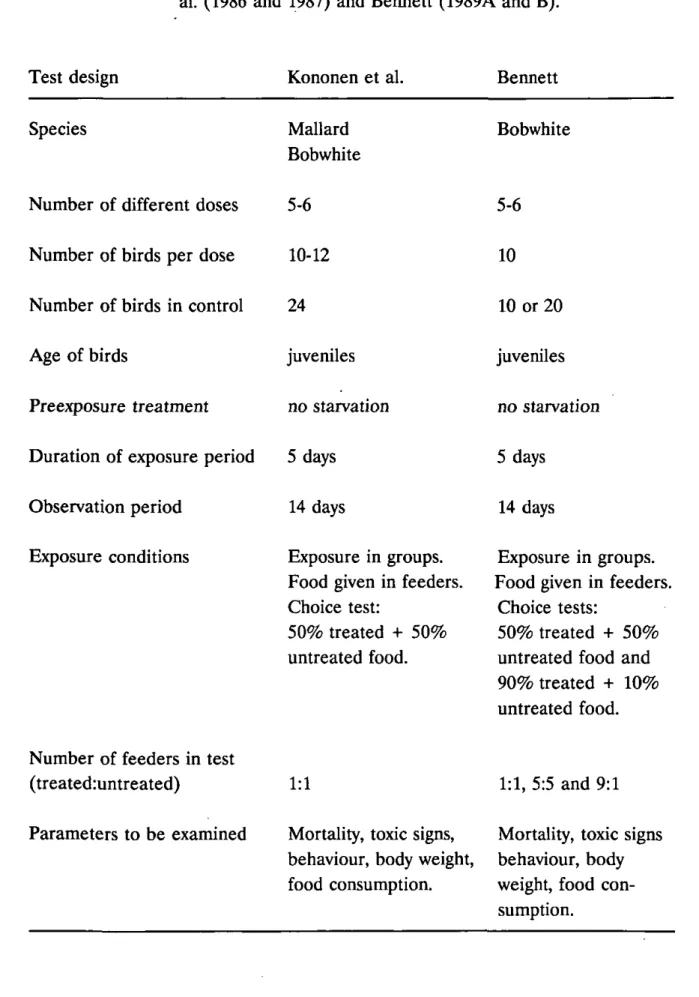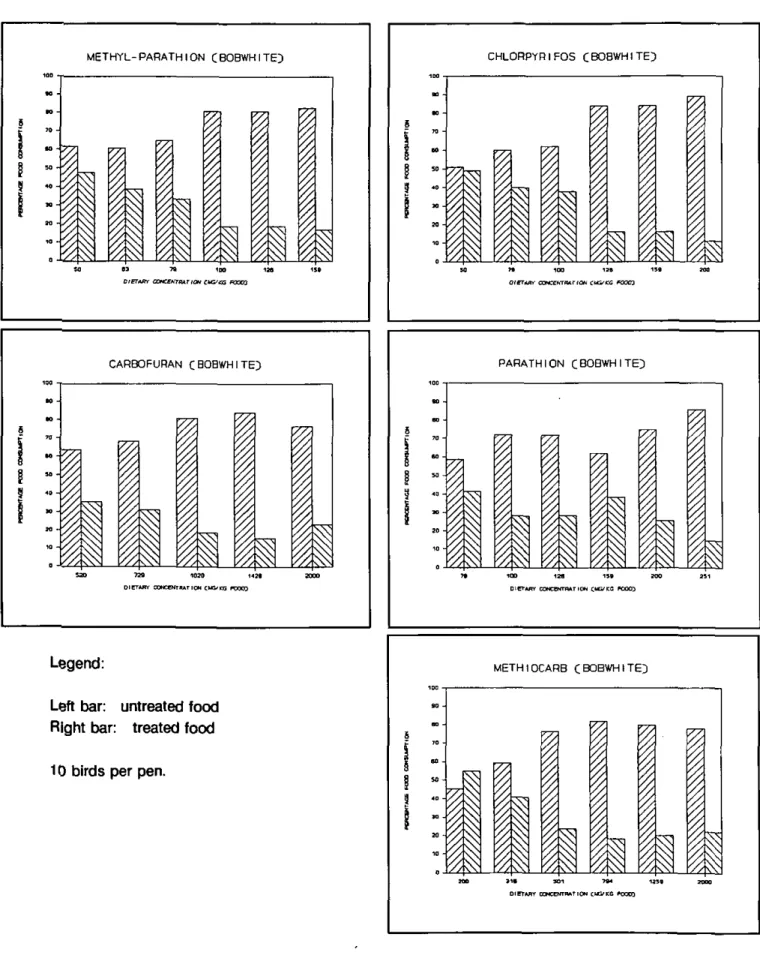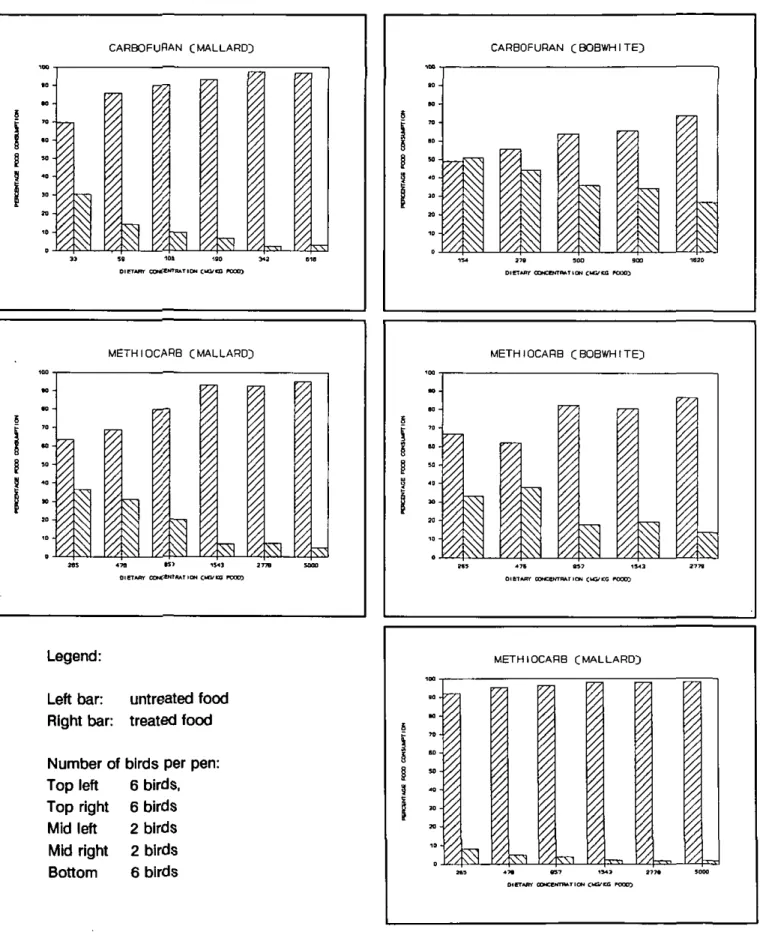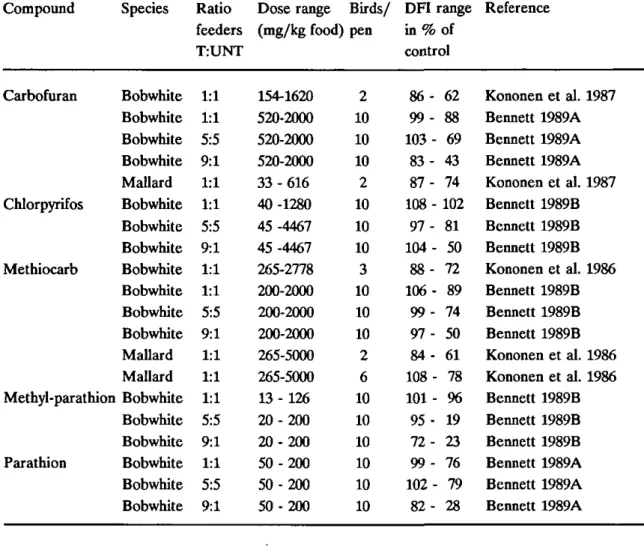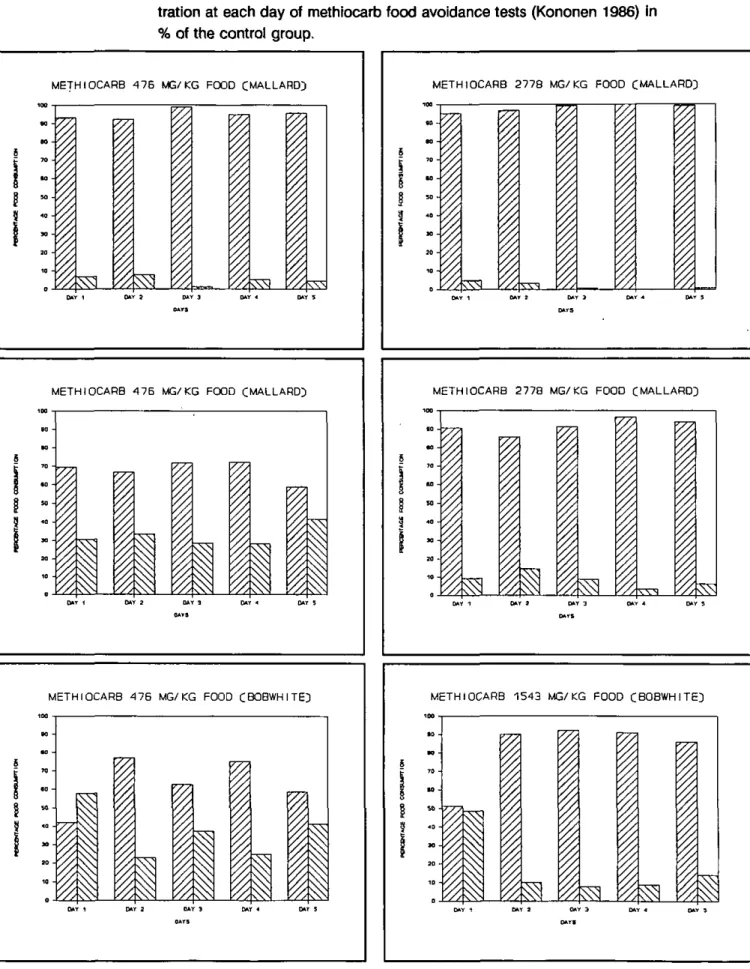V
NATIONAL INSTITUTE OF PUBLIC HEALTH AND ENVIRONMENTAL PROTECTION BILTHOVEN. THE NETHERLANDS
Report nr. 679102019
Environmental hazard/risk assessment of pesticides used in agriculture for birds and mammais. The Dutch concept. Part 2. Avian food avoidance behaviour.
R. Luttik
September 1993
This study was performed on behalf of and commissioned by the Directorate-General for Environmental Protection, the Directorate for Drinl<ing water, Water and Agriculture and the Directorate for Chemicals, Safety and Radiation Protection, in the frame of project 679102.
Mailinc List
1 - 1 0 Directoraat-Generaal Milieubeheer, Directie Drinl<water, Water en Landbouw, d.t.v. Ir.H.E.van de Baan
1 1 - 1 5 Directoraat-Generaal Milieubeheer, Directie Stoffen, Veiligheid en Straling, d.t.v. Ir.P.T.J.van der Zandt
16 Directeur-generaal Milieubeheer, Ir.M.E.E.Enthoven 17 Plv.DIrecteur-generaal Milieubeheer, Dr.lr.B.C.J.Zoeteman 18 Plv.DIrecteur-generaal Milieubeheer, Mr.G.J.R.Wolters 19 - 28 EPPO subgroup vertebrates, d.t.v. Dr.P.Greig-SmIth 29 - 33 Secretaris CTB te Wagenlngen, d.t.v. Drs.J.Poolman 34 - 42 Steungroep-M, d.t.v. Ir.R.v.d.Berg
43 Drs. G.R.de Snoo, Centrum voor Milieukunde, Rijksuniversiteit van Leiden
44 Prof.Dr.H.A.Udo de Haes, Centrum voor Milieukunde, Rijksuniversiteit van Leiden 45 Drs.A.Leopold, NOTOX, 's Hertogenbosch
46 Dr.l.M.Smith, European and Mediterranean Plant Protection Organization, Paris 47 Dr.P.MIneau, National Wildlife Research Center, Ottawa
48 Dr.A.Hart, MAFF Central Science l_aboratory, Worplesdon 49 Dr.G.GrolIeau, INRA, l_aboratoire de Phytopharmacie, Versailles 50 Dr.R.S.Bennett, Corvallis Environmental Research l_aboratory, Corvallis
51 Dr.D.W.Kononen, Department of Animal Science and Center for Environmental Toxicology, Michigan State University, East Lansing
52 Depot van Nederlandse publikaties en Nederlandse bibliografie 53 Directie RIVM
54 Sectordirecteur Stoffen en Risico's, Dr.lr.G.de Mik
55 Sectordirecteur Milieuonderzoek, Prof.Dr.lr.C.van den Akker 56 Sectordirecteur Toekomstverkenning, Ir.F.Langeweg 57 Hoofd Adviescentrum Toxicologie, Mw.Drs.A.G.A.C.Knaap 58 Hoofd laboratorium voor Ecotoxicologle, Prof.Dr.H.A.M.de Kruijf
59 Hoofd l_aboratorium voor Bodem en Grondwateronderzoek, Drs.LH.M.Kohsiek 60 Hoofd Laboratorium voor Afvalstoffen en Emissies, Ir.A.H.M.Bresser
61 Hoofd Laboratorium voor Toxicologie, Dr.W.H.Könemann
62 Hoofd Afdeling Voorlichting en Public Relations, Mw.Drs.J.A.Lijdsman-Schrijvenaar. 63 Ir.R.v.d.Berg, Laboratorium voor Bodem en Grondwateronderzoek
64 Ir.J.B.H.J.Linders, Adviescentrum Toxicologie
65 Dr.J.A.Hoekstra, Centrum voor Wiskundige Methoden
66 - 73 Projectleider, taakgroepleden UBS/BNS, d.t.v. Drs.T.G.Vermeire 74 - 78 Adviesgroep Toxicologie I, d.tv. Mw.Drs.A.G.A.C.Knaap
79 - 85 Adviesgroep Toxicologie II, d.t.v. Drs.J.H.Canton
86 - 90 Adviescentrum Toxicologie, d.t.v. Mw.Drs.A.G.A.C.Knaap 91 Auteur
92 Bureau projecten- en rapportenregistratie 93 Bibliotheek RIVM
Table of Contents MAILING LIST II TABLE OF CONTENTS HI ACKNOWLEDGEMENT IV SUMMARY V SAMENVATTING VI 1 INTRODUCTION 1 2 AVIAN DIETARY LC50 TESTS 3
2.1 Standard LC50 test 3 2.2 Evaluation of LC50 tests 4
3 FOOD AVOIDANCE TESTS 7 3.1 Introduction 7 3.2 BBA 25-1 and INRA test 7
3.3 Median food avoidance test 9 3.4 Evaluation of food avoidance test of Kononen et al. and Bennett 9
4 NO REPELLENT CONCENTRATION (NoRC) 20
4.1 Introduction 20 4.2 Calculation of NoRC from the LC50 test 20
4.3 Results 20 5 DISCUSSION AND RECOMMENDATIONS 22
6 REFERENCES 25 APPENDIX 27
IV Acknowiedgement
I would like to thank Janneke Hoekstra for the statistical help and Annegaaike Leopold and Dik van de Meent for the stimulating discussions and Theo Vermeire and Jan Linders for the critical reading of the manuscript.
Summary
The purpose of this report (the second one of a series in which the methodology for hazard/risk assessment of the use of pesticides for birds and mammais will be
presented) is to give a method for taking into account the avoidance behaviour in the evaluation of LC50 studies and to provide a concept for the use of food avoidance behaviour in the environmental hazard/risk assessment of pesticides used in
agriculture for birds.
An analysis is made of the standard dietary LC50 test and of 3 types of food
avoidance tests. It is concluded that the standard dietary LC50 test provides most of the information necessary to understand the repellent properties of a pesticide. It is recommended to measure the food consumption daily, to provide information about the learning abilities of the species tested (when does food avoidance appear). A method is proposed to calculate the No Repellent Concentration (NoRC). The NoRC is the concentration in the treated food at which the birds in the test will eat the same amount of treated food as the amount of (untreated) food in the control group. Data of the range finding tests can be used to design the 1X50 test (which doses will be tested) to provide a better estimation of the NoRC value.
These small alterations of the standard LC50 test make other repellency tests with birds superfluous, because the standard LC50 test is providing enough information about the repellent properties of the substance. Those repellency tests can be used to provide information about the edibility of the granulates and seeds (coated or
pillorized, but not treated vidth a substance), which results in less suffering of test animals.
VI
Samenvatting
Dit rapport is het tweede van een serie waarin een methode voor de beoordeling van het risico van het gebruik van bestrijdingsmiddelen voor vogels en zoogdieren wordt gepresenteerd. Het doel van dit rapport is aan te geven hoe de repellente
eigenschappen van bestrijdingsmiddelen kunnen worden meegenomen in de risicoschatting.
De standaard 5 dagen dieetstudie (LC50) en 3 typen vermijdingstesten werden geanalyseerd (repellency/food avoidance tests). De standaard LC50 geeft bijna alle informatie die nodig is om de repellente eigenschappen van stoffen te kunnen begrijpen. Het wordt aanbevolen de voedselconsumptie dagelijks te meten, zodat informatie beschikbaar komt over het tijdstip wanneer de vogel het vermijdingsgedrag gaat vertonen.
Er wordt een methode gepresenteerd waarmee de "No Repellent Concentration" (NoRC) kan worden berekend. De NoRC is die concentratie in het behandelde voer waarbij de vogels in de test net zoveel eten van het voer als in de controle test. Data van de "range finding test" kunnen gebruikt worden, voor de keuze van de
doseringsreeks in de LC50 test, zodat een betere bepaling van de NoRC kan plaatsvinden.
Deze kleine veranderingen van de standaard LC50 test maken andere
vermijdingstesten met het bestrijdingsmiddel overbodig. Deze testen kunnen wel
gebruikt worden om te bepalen of een granulaat of een gecoat of gepilleerd zaad (dus zonder toevoeging van een bestrijdingsmiddel) door vogels worden opgegeten, met het resultaat dat de geteste vogels gedurende de test minder te lijden zullen hebben.
1. Introduction
The purpose of this report (the second one of a series in which the methodology for hazard/risk assessment of the use of pesticides for birds and mammals will be presented) is to give a method for taking into account the avoidance behav-iour in the evaluation of LC50 studies and to provide a concept for the use of food avoidance behaviour in the environmental hazard/risk assessment of pesticides used in agriculture for birds.
In part 1 (Luttik 1992) a general introduction to the subject is presented and a synopsis of the decision scheme is given.
The ability of birds to detect and avoid toxic foods has been demonstrated vnth several pesticides (Bennett 1989A and 1989B, Conover 1984, Grue 1982 and Kononen et al. 1986 and 1987). In many 5-d avian dietary LC50 tests a dose related decrease in food consumption can be noticed (Table 1).
Table 1 Range of food consumption in % of the food consumption of the control group according to the dose range in 1X50 tests.
Compound Methiocarb Methiocarb Carbofuran Carbofuran Parathion Carbofuran Methiocarb Chlorpyrifos Methyl-parathion Dicrotophos Dicrotophos Methyl-parathion Fenthion Fenthion Fenitrothion Fenitrothion Species Mallard Bobwhite Mallard Bobwhite Bobwhite Bobwhite Bobwhite Bobwhite Bobwhite Common Crackles Common Crackles Common Crackles Common Crackles Common Crackles Common Crackles Common Crackles Dose rai^e (mg/kg food) 265-5000 265-2778 33- 616 86-1620 79-251 520-2000 200-2000 178-1778 50- 159 10-200 10-200 25-400 25-400 30-120 100-1600 25-100 Food consumption 5 9 - 3 8 2 - 4 3 4 0 - 5 8 6 - 2 9 5 8 - 2 1 8 2 - 4 0 9 5 - 1 9 9 2 - 1 2 4 6 - 1 3 2 7 - 3 4 9 - 4 8 7 - 6 7 0 - 6 2 8 - 7 2 5 - 5 8 7 - 3 7 Reference Kononen et al. 1986 Kononen et al. 1986 Kononen et al. 1987 Kononen et al. 1987 Bennett 1989A Bennett 1989A Bennett 1989A Bennett 1989B Bennett 1989B Grue 1982 Grue 1982 Grue 1982 Grue 1982 Grue 1982 Grue 1982 Grue 1982
In controlled-feeding tests with groups of juvenile Mallards (Anas platyrhynchos) and Northern Bobwhite (Colinus virginianus) with a free choice between two feeders - one containing untreated food and the other containing one of several dietary concentrations of test chemical - birds responded to the presence of many chemicals at sublethal concentrations by decreasing the proportion of treated food consumed mostly wdthout reducing the total food consumption, thereby reducing the occurrence of toxic effects (Table 2).
From the data presented in table 1 and 2 it is obvious that these bird species are able to detect the test chemicals in their food, which results in a food avoidance behaviour of these species.
Table 2 Food consumption in avian food avoidance behaviour tests (g/b-d).
Carbofuran Bobwhite Methiocarb Bobwhite
Dose Food consumption Untreated Treated (mg/kg food) (g/b-d) (g/b-d)
Dose Food consumption Untreated Treated (mg/kg food) (g/b-d) (g/b-d)
0
520 729 1020 1428 2000 6.8 4.1 4.6 5.2 5.4 4.6 2.3 2.1 1.2 1.0 1.40
200 316 501 794 1259 2000 7,0 2,9 3.9 4.2 5.4 6.7 5.3 „ 3.5 2.7 2.4 1.1 0.7 0.9Carbofuran Mallard Methiocarb Mallard
Dose Food consumption Untreated Treated (mg/kg food) (g/b-d) (g/b-d)
Dose Food consumption Untreated Treated (mg/kg food) (g/b-d) (g/b-d)
0
33 59 106 190 243 616 56 32 37 43 43 45 35 „ 146
5
3
1
1
0
265 476 857 1543 2778 5000 50 42 51 43 46 42 38 „4
3
2
1
1
1
g/b-d = gram food per bird per day. Data on Bobwhite from Bennett (1989A) and on Mallards from Kononen et al. (1986).
2, Avian dietary LC50 tests
2.1. Standard LC50 test
The principle of the OECD guideline for testing of chemicals number 205 (Avian Dietary Toxicity Test) is that birds are fed a diet containing the test substance at a range of concentrations for a period of five days. Begirming on day 6, the birds are fed basal diet, free of the test substance, for a minimum of three additional days (OECD 1984).
Conditions for the validity of the test are:
Two control groups, and one treatment group for each of the, at least, five dietary levels of the test substance should be used. Each group consists of 10 birds.
Diets containing the test substance should be available ad libitum.
The mortality in the controls should not exceed 10 per cent at the end of the test.
There must be evidence that the concentration of the substance should be at least 80 per cent of the nominal concentration throughout the five days of the test period.
The lowest treatment level should not result in compound-related mortality or other observable toxic effects.
The results should include the following information:
Number of deaths at each treatment level and in the control groups.
Average body weights for live birds in each pen at the beginning of the test, the end of the exposure period, and at the end of the test; individual weight of all birds that die during the test.
Description of all signs of intoxication and other abnormal behaviour, including day of onset, duration, severity, and numbers affected in the different dietary concentrations and controls each day of the test period. Estimated food consumption, by weigh-back method, per pen for the expo-sure period and the postexpoexpo-sure period.
Calculated LC50 value, 95 per cent confidence limits, slope of the tion-response curve, the results of a goodness-of-fit test, highest concentra-tion causing no mortality and lowest causing 100 per cent mortality. The statistical methods used should be described or the reference given.
Anything unusual about the test, any deviation from the procedures, and any other relevant information.
2.2. Evaluation of LC50 tests
The calculation of the LC50 and its confidence limits is based on the assumption that birds exposed to certain dietary concentrations of a test chemical will
consume the same amount of food in each treatment level. Very often this is not true (see example in Table 3). The assumed daily food intake (DFI) can be quite different from the measured DFI. According to the differences between the assumed and measured DFIs the assumed and measured daily chemical intake (DCI) will be different. Some more examples can be found in Figure 1. This reduced food consumption can be induced by repellent properties of chemicals:
taste repellents (chemicals that make food distastfull to the animals eating it, e.g. copper oxalate (Conover 1984)),
aversive conditioners (animals experience illness after consuming treated food, associate the illness with the food and avoid it thereafter, e.g lithium chloride (Conover 1984)),
anorexia inducers (chemicals that reduce the food consumption by one or an other way effecting the feeding behaviour of animals, e.g. methyl-parathion, fenthion (Grue 1982)),
or chemicals with a combination of properties (e.g. methiocarb (Conover 1984)).
Table 3 Difference between assumed and measured DFI and DCI and percentage mortality in a LC50 test whh Bobwhite and parathion (Bennett 1989A)
Dietary Assumed measured Assumed Measured Mortality Concentration DFI DFI DCI DCI
(mg/kg food) (g/b-d) (g/b-d) (mg/b-d) (mg/b-d) (%)
0
79 100 126 159 200 251 7.2 7.2 7,2 7.2 7.2 7.2 7,2 7.2 4.2 3.8 4.5 2.9 2.0 1.5 0.00 0.57 0.72 0.91 1.15 1.44 1.81 0.00 0.33 0.38 0.68 0.46 0.40 0.380
0
0
20 50 60 80Figure 1 Difference between assumed and measured DFI and DCI in LC50 tests with Bobwhite (Bennett 1989A and B) and Mallard (Kononen 1987). Left bar is assumed and right bar Is measured DFI or DCI.
.C5D TEST WITH CHLORPYRI FOS
m
• ^ § ' ^ ^ ^ § ^ $ ^ § $^§zh
y ^ ^ $
yk ^k
i
^ ^m
m
i
^ i
11
^ \ ^ DOSE 3 D C U I DOS£L C 5 0 TEST WITH CARBOFURAN HORTHCnN DOCrVHITG
I
m
m
m
1
ill
[ÜÜ
•ji
DCSE 1 OME 1I
11
L C 5 0 TEST WITH METHIOCARB W L L i n o Duci:
^ 1 1
^ ^ ^ '/y 9, Z ZL
I
^ g s
^ ^ ^ ^ ^ ^ ^ ^ ^ ^ ^ ^ ^ ^ ^ ^ ^ ^ ^z^ z
z z
^ ^ ^ S Li
DOSE Ï e o s i 1 r R l A T 1 . 0 ( r L M T LLC50 TEST WITH CHLORPYRIFOS
t ? ^ ^ ^ ^
^a
B
i^
i
D O a Ï DOSE 3 COSE • COSE 9
r R e * T i . e j T L C V T L S
LCSO TEST WITH CARBOFURAN NCATUERN BC0MITG
i
i
ilg i
i
11 11
I
D O » 1 DO«C ) DOSS t
LC5D TEST WITH METHIOCARB U t l l U D DUCK
From Table 3, it is remarkable that a dose-related response is found in spite of the fact that the daily chemical intake does not differ much between the treat-ment levels. The same can be noticed in the examples of Figure 1 (see table 4). Table 4 Measured daily chemical intake (DCI) and mortality in 3 LC50 studies
with Bobwhite for chlorpyrifos, carbofuran and methiocarb (Beimett 1989A and B). Chlorpyrifos Bobwhite Carbofuran Bobwhite Methiocarb Mallard DCI Mort. (mg/b-d) (%) DCI Mort. (mg/b-d) (%) DCI Mort. (mg/b-d) (%) Dose 1 Dose 2 Dose 3 Dose 4 Dose 5 Dose 6 1.10 1.18 1.70 1.20 1.35 1.24
0
0
6
56 94 100 2.91 3.06 3.67 3.14 5.40 20 20 30 60 90 6.10 7.09 2.74 3.86 5.56 5.500
17 25 17 33 42Beimett (1989A) observed in the test with carbofuran (Bobwhite) two types of mortality:
A) Acute poisoning within 1 day, with little or no weight loss (average loss 5%) and
B) death occurring 3 to 6 days from test initiation, with significant weight loss (average loss 38%).
In the tests with parathion and methiocarb all bird mortality occurred between day 3 and 6, with an average weight loss of 37% (21-43%) for parathion and an average loss of 40% (35-47%) for methiocarb (Bennett 1989A).
The other study of Bennett (1989B) and the study of Grue (1982) do not mention the time of death of the test birds, but considering the average weight loss of the dead birds, a type B mortality must be the case. Kononen et al. (1986 and 1987) did not give body weights of dead birds.
had an average loss of 38% of their body weight (range 20-47%). Common Grackles that died during the LC50 tests carried out by Grue (1982) with dicrotophos, methyl-parathion, fenthion and fenitrothion lost an average of 28-36% of their initial body weight. These values exceed those reported by Hill (1972) for House Sparrows (Passer domesticus) after starvation: average weight loss 21.4% (17-25%). Visible fat was absent in birds that died and muscle tissue was reduced on the sternum of the Common Crackles. Mortality following
dietary exposure of dicrotophos increased between May and August, although chemical intake remained relatively constant. The observed increase in mortality was associated by Grue (1984) with a natural decrease in fat and flesh condition in response to increased ambient temperatures (21-31 °C) and post-nuptial moult. The data presented in this chapter indicate that LC50s, when marked decrease in food consumption is noticed, should be considered as a measure of the relative vulnerability of a species to a dietary exposure to a toxicant and not as sensitivity,
3. Food avoidance tests
3.1. Introduction
The search for bird repellents to protect seeds and agricultural crops and the evaluation of chemicals as repellents for protecting paper, plastics, and textile packaging materials from rodent damage has been in progress for many decades. Tigner and Besser (1962) developed a method, a concentration-repellent effect determination, to express quantitatively rodent repellency of chemicals on packaging materials. The method yields an expression of effectiveness in terms of the concentration required to repel 50% of test rodents (R50). the confidence limits (95%) and a regression line that allows the estimation of the concentration that repels any given percentage of test animals. Starr et al. (1964) adapted this method to birds.
In recent years several acceptance/palatability tests have been developed for birds: BBA 25-1 (BBA 1981), INRA test (INRA 1990) and Median food avoidance test (Kononen 1986 and Bennett 1989A).
3.2. BBA 25-1 and INRA test
Both tests are designed to give information about the behaviour of birds when they are exposed to a formulation of a chemical at the normal field dosage. A short description of the BBA 25-1 and INRA test is given in table 5.
8
birds have a choice between 75% treated and 25% untreated food and the non-aggravated choice test of 10% treated and 90% untreated food. The food is spread out on the floors of the aviaries. The INRA test has also an aggravated test in which the birds have no choice (100% treated food) and a non-aggravated test in which the birds have a choice between 50% treated and 50% untreated food in separate feeders. These two tests have one serious shortcoming: only one concentration is tested. When more concentrations are used in the field more tests have to be performed. An other shortcoming is the fact that birds in the field have no choice at the treated area but have only the choice of eating and not eating (and looking for an other feeding place). This situation is partly covered in the aggravated experiment of the INRA test.
Table 5 Design of BBA 25-1 and INRA test.
Test design/parameter BBA 25-1 INRA
Species Japanese quail Common Partridge
Ring-necked Pheasant Red-legged Partridge Minimum number of replicates 3 (quail) 2 (pheasant) 1
Control group no yes
Number of birds per test 8 (quail) 5 (pheasant) 10-12
Age of birds adults not specified
Preexposure treatment 16 h starvation no starvation
Duration of exposure period 8 hours for quails 24 hours 7 days for pheasant
Observation period 14 days 14 days
Parameters to be examined Mortality, toxic signs. Mortality, toxic signs behaviour, body weight, body weight, food (gross pathology). consumption, (gross
Table 5 Continued
Test design/parameter BBA 25-1 INRA
Exposure conditions Exposure in groups. Food spread out on sandy floor of aviaries. 1. Aggravated test: choice test, 75% treated
+ 25% untreated food. 2. Non-aggravated test: choice test, 10% treated
-I- 90% untreated food
Exposure individually in cages. Food given in feeders.
1. Aggravated test: no choice test, 100% treated food,
2. Non-aggravated test: choice test, 50% treated + 50%
untreated food in separate feeders.
3.3. Median food avoidance test
In analogy to the median lethal concentration (LC50) of the avian dietary test, a medium food avoidance concentration is the maximum concentration of a test compound that is expected to result in equal consumption of treated and untreated feed by a group of animals given free access to both clean and contaminated feed (Kononen et al. 1986). This concentration is the highest expected dietary concentration of toxicant that will not result in detectable avoidance behaviour by an exposed population. This concentration is named by Kononen et al. (1986) the FAC50 value (median food avoidance concentration) and by Beimett (1989A) the DT value (discrimination threshold).
A short description of the test performed by Kononen et al. (1986 and 1987) and Bennett (1989A and B) is given in Table 6.
3.4, Evaluation of food avoidance test of Kononen et al. and Beimett The FAC50 or DT values of the studies carried out by Kononen et al. and Bennett are presented in Table 7. The FAC50 value of Kononen et al. were calculated in the same manner as the LC50s (probit analysis) except the response variable was the proportion of total food that was treated food (see also Kononen 1988). The DT values of Bennett were calculated as the
intersec-10
Table 6 Description of food avoidance tests according to Kononen et al. (1986 and 1987) and Bennett (1989A and B).
Test design Kononen et al. Bennett
Species Mallard
Bobwhite
Bobwhite
Number of different doses 5-6 5-6
Number of birds per dose 10-12 Number of birds in control 24
10 10 or 20
Age of birds juveniles juveniles
Preexposure treatment no starvation no starvation
Duration of exposure period 5 days Observation period
Exposure conditions
14 days
Exposure in groups. Food given in feeders. Choice test: 50% treated + 50% untreated food. 5 days 14 days Exposure in groups. Food given in feeders.
Choice tests:
50% treated -^ 50% untreated food and 90% treated + 10% untreated food. Number of feeders in test
(treated:untreated)
Parameters to be examined
1:1 1:1, 5:5 and 9:1
Mortality, toxic signs, Mortality, toxic signs behaviour, body weight, behaviour, body food consumption. weight, food
11
tion of a two-phase regression analysis using the log of the ratio of untreated to treated food consumption as the dependent variable and the log of the concen-tration of treated food as the independent variable (Bennett and Schafer 1988). For convenience the concentration of the compound by which the bird species will not make a difference between treated and untreated food will be called the discrimination threshold (DT) in this report.
In all cases were birds where offered the choice between treated and untreated food in two feeders per cage (1:1) a dose related food avoidance was noticed and DT values could be calculated (see also Figure 2A and 2B). When the same species was tested by Bennett and Kononen et al. the difference between the DT values were a factor 1.1 and 2.4 for carbofuran and methiocarb, respectively, A marked difference was found in the case of the study with methiocarb and Mallards carried out with 2 birds per pen and with 6 birds per pen. When 6 birds are put in one pen the DT value was approximately 100 times lower than when 2 birds were put in one pen. Although only information from one study is available these results suggest that the avoidance response of young Mallards to methiocarb-treated food is strongly influenced by factors such as the number of birds per pen or the amount of floor space allotted to each bird.
In all studies of Bennett (1989A and 1989B) little or no reduction in total food consumption was observed from control to treated groups because increased consumption of untreated food compensated for reduction in consumption of treated food (see also Table 8), No mortalities or signs of intoxication were observed in the tests with chlorpyrifos, methyl-parathion and parathion. In the test with methiocarb only 1 bird died at the highest concentration tested (this was the smallest bird; day 0 weight = 20 g, compared to a mean weight = 32 g for all birds). In the test with carbofuran 3 mortahties on day 1 from acute poisoning were observed.
In the studies of Kononen et al. (1986 and 1987) little reduction in food con-sumption was noticed (not significant, P>0.05) in the studies with the Bobwhite. In the studies with Mallards little or no reduction in food consumption was noticed except at the highest concentration tested (significant, P<0.01), but a not doses related decrease in food intake was measured in the study with 2 birds per pen with methiocarb (3 cases significant less than the control, P<0.01). Mortal-ities were noticed in 4 of the five tests carried out (2 to 9 dead birds) except the test with methiocarb with 6 Mallards per pen.
In the studies of Bennett (1989A and 1989B) where Bobwhite were offered treated and untreated food in 5 feeders each per cage (5:5) a dose related food avoidance was noticed and DT values could be calculated. The DT values for
12
Table 7 Discrimination threshold values and LC50 values (mg/kg food) from studies carried out by Kononen et al. and Bennett.
Compound Species DT value LC50
(mg/kg fd) (mg/kg fd)
Reference
Two feeders/cage, one containing treated food and one untreated food: Carbofuran Chlorpyrifos Methiocarb Methyl-parathion Parathion Bobwhite Bobwhite Mallard Bobwhite Bobwhite Bobwhite Mallard^ Mallard^ Bobwhite Bobwhite 170 159 10 63 224 95 145 1.5 10 33 1144 917 242 647 1457 827 7469 91 177 Bennett 1989A Kononen et al. 1987 Kononen et al. 1987 Bennett 1989B Bennett 1989A Kononen et al. 1986 Kononen et al. 1986 Kononen et al. 1986 Bennett 1989B Bennett 1989A Ten feeders/cage, five containing treated food and five untreated food: Carbofuran Chlorpyrifos Methiocarb Methyl-parathion Parathion Bobwhite Bobwhite Bobwhite Bobwhite Bobwhite 400 26 222 45 38 1144 647 1457 91 177 Bennett 1989A Bennett 1989B Bennett 1989A Bennett 1989B Bennett 1989A Ten feeders/cage, nine containing treated food and one untreated food: Carbofuran Bobwhite Chlorpyrifos Bobwhite 71 Methiocarb Bobwhite >1259 Methyl-parathion Bobwhite > 126 Parathion Bobwhite 1144 647 1457 91 177 Bennett 1989A Bennett 1989B Bennett 1989A Bennett 1989B Bennett 1989A ^ = 2 birds per pen. ^ = 6 birds per pen.
13
Figure 2A Percentages of food consumption by Bobwhite in food avoidance tests (Bennett ig89A and B).
METHYL-PARATHION CBOBWHITE:) )0 u -^ 51 40 10 -10 •
li
•
I
•
ll
11
11
I
r / ^ ^ ^ M B3 TS 1D0 1 M DIETtlTY CCHCEKTCHT lOK C l i C a i FCOmCARBOFURAN CBOBWHITE:)
1
a
I
I
i^
n
I
» a 1 0 » 1 D I E T U n DOKXHTUTION C K U o ; nXCO I» aioo Legend:Left bar: untreated food Right bar: treated food 10 birds per pen.
CHLORPYRIFOS CBOBWHITE^ TO M -g ' " 3 40 • M -»-
i
i i
m
I
ii
g§
11 il
^ n 100 13B 1 Ï 9 3oa PARATHION C B O B W H I T E : )i
I
^ g
i
i
, IQD 128 1 Ï V 300 DICT4RY CONCCKTFUT ION ^Mtk^CG KXXOMETH1ÜCARB CBOBWHITE:)
i
Vyi
i
=14
Figure 2B Percentages of food consumption by Bobwhite and Mallards in food avoidance tests (Kononen 1986 & 1987).
CARBOFURAN CMALLARD^ 100 •0 -• 0 ' TO «0 -g SO 9 40 H R ' " ' JO 10
-i
i i
^^ 8
I I
i
SS Ï S 10B i a o 3*3 B i a METHIOCARB C M A L L A R D : ) 100 •0 (0 JO «0-1
iui
M S 470 *S> 1 t 4 J 3TJBitlalsJs
OIETIUIT C C M t * « " « t l O N C I " » » : FCOCO Legend:Left bar: untreated food Right bar: treated food Number of birds per pen: Top left 6 birds, Top right 6 birds Mid left 2 birds Mid right 2 birds Bottom 6 birds
CARBOFURAN CBOBWHI TED
3 TO SOO 900 D i E T i x r cONCEHTnikTiaN c c / r a K o c o METHIOCARB CBOBWHITE:)
"f
I Li
11
i
i i
iliiiiiilÉ
i
J
o i E t i H T c o N c e w i m r i m c i c e o 1 x 0 3 METHIOCARB CMALLARD^ S so l | ' 0 Q 10 M-l a
V'TCl 2 3:a_ [ ^I
^ = 3 2 -i
15
Table 8 Daily food intake in percentages of the Daily food intake of the control group according to the dose range.
Compound Species Ratio Dose range Birds/ DFI range Reference feeders (mg/kg food) pen in % of
T:UNT control Carbofuran Chlorpyrifos Methiocarb Bobwhite Bobwhite Bobwhite Bobwhite Mallard Bobwhite Bobwhite Bobwhite Bobwhite Bobwhite Bobwhite Bobwhite Mallard Mallard Methyl-parathion Bobwhite Parathion Bobwhite Bobwhite Bobwhite Bobwhite Bobwhite 1:1 1:1 5:5 9:1 1:1 1:1 5:5 9:1 1:1 1:1 5:5 9:1 1:1 1:1 1:1 5:5 9:1 1:1 5:5 9:1 154-1620 520-2000 520-2000 520-2000 33 - 616 40-1280 45-4467 45-4467 265-2778 200-2000 200-2000 200-2000 265-5000 265-5000 1 3 - 1 2 6 2 0 - 2 0 0 2 0 - 2 0 0 5 0 - 2 0 0 5 0 - 2 0 0 5 0 - 2 0 0 2 10 10 10 2 10 10 10 3 10 10 10 2 6 10 10 10 10 10 10 8 6 9 9 - 1038 3 8 7 - 1089 7 - 1048 1048 - 1069 1069 9 7 8 4 - 1081 0 1081 9 5 7 2 9 9 - 1028 2 -62 88 69 43 74 102 81 50 72 89 74 50 61 78 96 19 23 76 79 28 Kononen et al. 1987 Bennett 1989A Bennett 1989A Bennett 1989A Kononen et al. 1987 Bennett 1989B Bennett 1989B Bennett 1989B Kononen et al. 1986 Bennett 1989B Bennett 1989B Bennett 1989B Kononen et al. 1986 Kononen et al. 1986 Bennett 1989B Bennett 1989B Bennett 1989B Bennett 1989A Bennett 1989A Bennett 1989A
methiocarb and parathion found in the 1:1 choice did not differ from those in the 5:5 choice (224 and 222 mg/kg food for methiocarb and 33 and 38 mg/kg food for parathion). For carbofuran and methyl-parathion lower DT values were found in the 1:1 choice than in the 5:5 choice (170 versus 400 mg/kg food for carbofuran and 10 versus 45 mg/kg food for methyl-parathion). For chlorpyrifos a lower DT value was found in the 5:5 choice than in the 1:1 choice (26 versus 63 mg/kg food).
Little or no food reduction was noticed in the tests with parathion, chlorpyrifos and carbofuran. In the tests with methiocarb and methyl parathion a dose related decrease in food consumption was observed (Table 8). No dead birds were found in the tests with parathion and methiocarb, 1 dead bird in the test with chlorpyrifos and 8 dead birds with methyl-parathion at the highest
concen-16
tration. In the test with carbofuran 5 day 1 mortalities occurred and 3 dead birds were found on day 3 and 4 of the test.
In the studies of Bennett (1989A and 1989B) were Bobwhite were offered treated and untreated food in 10 feeders per cage (9:1) a dose related food avoidance was only found in the study with chlorpyrifos (DT = 71 mg/kg food). In the tests with the other compounds the birds did not discriminate between the feeders, except m the highest concentration tested with methiocarb and methyl-parathion. In all tests a dose related decrease in food consumption was noticed (Table 8). The responses in these tests (except chlorpyrifos) were comparable to the LC50 tests, i.e. mortality, food consumption and body weight changes.
Although the birds were able to detect the presence of chlorpyrifos, some mortality did occur in the highest dietary concentrations in this test. In case of carbofuran 4 day 1 mortalities and 7 day 3-5 mortalities were observed and for methiocarb 1 day 1 and 4 day 3-5 mortalities.
The ability to detect and avoid lethal dietary exposures can be influenced by the number and relative proportion of treated and untreated food choices. The DT remained at sublethal concentrations in all chlorpyrifos tests, while increasing significantly in methyl-parathion tests as the number of feeders or relative proportion of treated feeders increased. The DTs of parathion, carbofuran and methiocarb remained at sublethal concentrations in the 1:1 and 5:5 tests, but increased significantly in the 9:1 test with methiocarb and no DTs could be estimated for the compounds parathion and carbofuran in the 9:1 tests. In contrast to the 1:1 and 5:5 tests, there was little or no discrimination in the 9:1 tests (except chlorpyrifos), and mortaHty approached levels observed in the LC50 tests, even though untreated food was available in ad libitum quantities.
Another important aspect to understanding food avoidance behaviour is the timing of formation of aversions. Bennett (1989A) noticed in the carbofuran choice tests that 50% of the mortality occurred on day 1, usually within the first few hours. Birds seemed to consume lethal quantities of the chemical before any food aversion was formed.
Kononen et al. (1986 and 1987) measured the food consumption of the test animals at each day of the food avoidance tests with methiocarb and carbofuran. The results of these measurements are graphically presented in Figure 3a and 3B. The Mallards exhibited definite avoidance behaviour on day 1 and through-out the remainder of the exposure periods. The Mallard test with methiocarb that utilized six birds per pen resulted in a stronger daily avoidance response
17
Figure 3A Food consumption by Bobwhite and Mallards at a certain dietary concen-tration at each day of methiocarb food avoidance tests (Kononen 1986) in % of the control group.
METHIOCARB 476 MG/KG FOOD CWALLARD:)
II
I i
^ ^Li
\ ^ ^ CUT i D*' 3METHIOCARB 47B MG/KG FOOD CMALLARD:)
«
3d
-i
11
IIMM*
M T 2 D*rI
DAÏSMETHIOCARB 476 MG/KG FOOD CBOBWHITE^
TO «0 M M 30 -10 -
i
I
I
I
1 1
I
M T 1 M r 3 O i r J M T o » r »METHIOCAHB 2 7 7 8 MG/KG FOOD C^ALLARD^
1
M 30-i
^ 2 ^I
^ssa.I
I;
0»T 1 B » I J DUI 4 D * ' 5METHIOCARB 2778 MG/KG FOOD CMALLARD:)
I i
^ D«r 1 ftir J METHIOCARB 1543 MG/KG FOOD C B O B W H I T E : ) 100 • 0 • 0 TO u -^ ^I
» r 3 otr 318
Figure 3B Food consumption by Bobwhite and Mallards at a certain dietary concen-tration at each day of carbofuran food avoidance tests (Kononen 1987) in % of the control group.
CARBOFURAN 59 MG/KG FOOD CMALLARD3
so •0
-1
\i
i
i
i
i
y/M
i
^ ^ D»r ' D*r 3 D»y a Q*r < D»r ïCARBOFURAN 154 MG/KG FOOD CBOBWHITE^
TO 60 -g 'OH I JO H so 10
-i -i
mm
^ 1
i
OAr 3 D u n c ; A R B O F U R A N 342 MG/KG FOOD CMALLARDn1 ""1
0 ' y V v ^ .1
!•AT 1 OAr 2 DAV ? CvKT 4 O^Y 5
CARBOFURAN 900 MG/KG FOOD CBQBWHITE3
90 ao TO ED 50
-^1
il
ZKS3_ CKT 3 M r 3 M r sLegend Figure 3A and 3B: Left bar: untreated food Right l3ar: treated food Number ot birds per pen: Figure 3a top graphs: 6 birds
mid + bottom graphs: 2 birds Figure 3b all graphs: 6 birds
19
than in the study with two birds per pen. Bobwhite demonstrated no avoidance behaviour on the first day of exposure, avoidance occurred on the second day of the exposure period and continued throughout the remainder of the exposure period. In three of the four examples they actually consumed more treated food than clean food (lowest carbofuran concentration is below the DT).
Discrimination thresholds can be used in the risk assessment by comparing these DTs with the concentrations that birds can encounter in the environment. It is assumed that the results of the Bobwhite can be used for the Common Quail (Cotumix cotumix). The diet of the Common Quail consists of small seeds and small insects (Glutz von Blotzheim et al., 1973). By using the relation between the concentration on crops/insects and the pesticide dosage immediately after application given by Hoerger and Kenaga (1972) and Kenaga (1973), an estima-tion of the environmental concentraestima-tion can be made for the Common Quail (see Table 9).
Table 9 The predicted environmental concentrations (PEC) for Common Quails and the DTs for Bobwhite.
Compound PEC^ Discrimination thresholds (1:1) (mg/kg food) Beimett Kononen et al. Carbofiiran 73 - 218 159 170 Chlorpyrifos 22 - 116 63
Methiocarb 7.3 - 29 224 96 Methyl-parathion 4.4 - 109 33
Parathion 4.4 - 109 10
1 = According to normal agricultural use in the Netherlands.
The lowest predicted environmental concentrations of the tested chemicals are below the DTs of these compounds. This would mean that Common Quails will not discriminate between treated and untreated food. Discrimination between treated and untreated food can occur in the highest predicted environmental concentrations, except for methiocarb (highest PEC below DT).
20
4. No Repellent Concentration (NoRC)
4.1. Introduction
Kononen et al. (1986 and 1987) and Bennet (1989A and 1989B) have defined the DT as the concentration in the treated food at which the birds are not discriminating between treated and untreated food when both types of food are available ad libitum. From the LC50 tests it is possible to estimate the concen-tration in the treated food at which the birds in the test will eat the same amount of treated food as the amount of (untreated) food in the control group. This discrimination threshold will be called the No Repellent Concentration (NoRC).
4.2. Calculation of NoRC
The dose-response relationship in the LC50 test is calculated using the log of the food consumption (FC) of the control group and the food consumption of the treated groups in gram per bird per day over the 5 days test period as the response-dependent variable, and the log of chemical concentration of treated food as the independent variable (y = log concentration in food, see also Figure 4). At dietary concentrations below the NoRC, the expected value of response, y
= log(FCcontroi/ï^Qreated)' should cqual 0, reflecting no difference between the food consumption in the control group and the treated group. The dose response relationship was calculated with the nonlinear regression analysis of Genstat 5 release 1.3 (Genstat 1988).
Because Kononen et al. (1986 and 1987) used the probit analysis for calculating the DT and Bennett and Schafer (1988) a two-phase regression analysis, the DTs are recalculated in the same way as for the NoRC values, using the log of the ratio of untreated to treated food consumption as the response-dependent variable (y = log(untreated FC/treated FC)), A description of the programs used in Genstat can be found in the appendix.
4.3. Results
In Table 10 the results of the calculations of the NoRCs for the LC50 studies and the food choice studies and the 95% confidence limits are presented (see also Figure 5).
21
Figure 4 Relationship of the log of the dietary concentration and the log of the food consumption in the 2 phase regression model for the LC50 study.
Table 10 Compound Carbofuran Carbofuran Carbofuran Chlorpyrifos Methiocarb Methiocarb Methiocarb Methyl-parathion Parathion
Calculated NoRC-values (mg/kg food) Species Bobwhite Bobwhite Mallard Bobwhite Bobwhite' Bobwhite Mallard Bobwhite Bobwhite LC50 test NoRC 67 348 11 213 390 297 138 23 53 95% confidence limits 4 - 1033 91 - 1329 1 - 159 138 - 303 193 - 789 63 - 1395 33 - 571 18 - 27 21 - 133 Choice test NoRC 150 167 11 48 208 98 159 10 33 95% confidence limits 93 - 244 7 - 4212 4 - 27 18 - 130 65 - 670 11 - 898 66 - 382 5 - 20 7 - 151 * = data on highest concentration tested not used for the nonlinear regression analysis (outlier).
22
There is no scientific reason to believe that the NoRCs based on the LC50 studies are different from the NoRCs based on the food choice experiments. The 95% confidence intervals are overlapping to a high degree. There is a small tendency that the NoRCs based on the LC50 studies are a little higher than the NoRCs based on the food choice experiments (the mean ratio is 1.96).
The NoRC based on the LC50 study with Mallards for carbofuran is equal to the NoRC based on the food choice experiment. The NoRCs based on the LC50 study with Bobwhite for carbofuran and with Mallards for methiocarb are lower than the NoRCs based on the food choice experiments. The 6 other NoRCs based on the LC50 studies are higher than those based on the food choice experiments.
NoRCs
LC3D VERSUS FOOD CHOICE TESTS 2 . B 2 . 6 -ff 2 -g ..Ö 2 -3 i . a -*_/ tS 1.B -UJ 1 . ^ -o Ö 1.2 Z D . B -5 D.B 0 . 4 0 . 2 -C D -0 . 4 O.B 1.2 1 . 6 2 2 , 4 2 . B LOGCN0RC3 CHOICE TEST C M j / K G F00O5
Figure 5 NoRC-values for the LC50 tests and the food choice tests.
(line in graph represents the case that the NoRC-values are equal).
5. Discussion and recommendations
From the studies analyzed in this report it is clear that the outcome of a LC50 test is not only the reflection of the intrinsic properties of the tested chemicals.
23
but also the reflection of the vulnerability of the species tested. The outcome is very often not the result of increasing dietary concentrations, but the result of decreasing food consumption. This food avoidance behaviour can be induced by repellent properties of the chemicals. Because repellency dictates sometimes to a high degree the outcome of the LC50 value, corrections for repellency in the hazard assessment must be appUed with care.
When evaluating LC50 studies for for instance registration purposes it is necessary to pay attention to the following points:
food consumption patterns, time dependent mortaHty and the No Repellent Concentration,
Food consumption patterns can give an impression of the role of repellent properties of the chemical. The time (in combination with changes in body
weight) at which mortalities occur (day 1 versus day 3-5) gives information about whether the mortalities are caused directly by the chemical or are the result of
starvation, or both. The No Repellent Concentration can be used for the hazard assessment by comparing this value with the predicted or measured concentra-tion in the food of animals which they can encounter in their environment. The INRA test is providing information about the mortality, toxic signs, body weight, food consumption and sometimes on gross pathology of two species of partridge exposed for 24 hours for two exposure conditions (100% treated and 50% treated and 50% untreated food; food given in feeders).
The BBA test is providing information about the mortaHty, toxic signs, behav-iour, body weight and sometimes on gross pathology of two species (adult
Japanese quail and Ring-necked Pheasant) exposed for respectively 8 hours or 7 days for two exposure conditions (75% treated and 25% untreated and 10% treated and 90% untreated food; food spread out on sandy floor of aviaries). Both tests are only providing information about a certain formulation tested at the field concentration for a particular treatment, mostly a granulate or a seed treatment. Because only special treatments are tested, this information is hardly usable for the hazard assessment of a concentration on the food which a bird can encounter in the field after spraying.
The experiments carried out by Bennett (1989A and 1989B) and Kononen et al. (1986 and 1987) provide information about the mortality, toxic signs, body weight and food consumption and about the discrimination threshold of the species
24
tested, exposed for 5 days for one exposure condition (50% treated and 50% untreated food; food given in feeders). In the tests carried out by Bennett
(1989A and 1989B) also the choice between 90% treated and 10% untreated food was investigated. The studies carried out by Kononen et al. (1986 and 1987) provide also information about the time when the test species is starting to show food avoidance behaviour, because they measured daily the food consumption. The imperfection of these tests and also of the BBA and INRA tests is the choice between treated and untreated food (exposure treatments) in the experi-ment. In the field birds usually will have no choice at the treated area but have only the choice of eating and not eating (and looking for an other feeding place). The standard LC50 test can provide already answers to some of the aspects of repellent properties of the compound tested:
1) the time at which the mortalities occur,
2) the body weight changes of the birds during the test,
3) the estimated food consumption, by weigh-back method, per pen for the exposure period and the postexposure period, and
4) the No Repellent Concentration.
By measuring the food consumption daily the learning abilities of the bird species can be investigated. Up to now the food consumption (mg/bird per day) is mostly based on a weigh-back method over the whole exposure period.
The LC50 test is strongly focused on the determination of the LC50 value. When the choice of the dosage range is also focused on the NoRC value better
information can be made available for the calculation of the NoRC. By measur-ing the daily food intake of the birds durmeasur-ing the range findmeasur-ing test the NoRC can be approximately determined. This data can be used for the design of the LC50 test.
These small alterations of the standard LC50 test make other repellency tests with birds superfluous, because the standard LC50 test is providing enough information about the repellent properties of the substance. Those repellency tests can be used to provide information about the edibility of the granulates and seeds (coated or pillorized, but not treated with a substance), which results in less suffering of test animals.
25
6. References
BBA (1981) Richtlinie zur Prüfung von Pflanzenbehandlungsmitteln auf Vogel gefahrdung - Annahmeversuche -. Richtlinien für die amtliche Prüfung von Pflanzenbehandlungsmitteln 25-1. Biologische Bundesanstalt für Land- und Forstwirtschaft, Berlin, Germany.
Beimett, R.S. and D.W. Schafer (1988) Procedure for evaluating the potential ability of birds to avoid chemically contaminated food. Environ. Toxicol. Chem. 7: 359-362.
Bennett, R.S. (1989A) Factors influencing discrimination between insecticide-treated and uninsecticide-treated foods by northern bobwhite. Arch. Environ. Contam. Toxicol. 18: 697-705.
Bennett, R.S. (1989B) Role of dietary choices in the ability of bobwhite to
discriminate between insecticide-treated and untreated food. Environ. Toxicol. Chem. 8: 731-738.
Conover, M.R. (1984) Response of birds to different types of food repellents. J, Appl, Ecol, 21: 437-443.
Genstat (1988) Genstat 5 Release 1.3 (DOS/386) Implemented by Marketing Risk Management. Copyright 1988. Lawes Agricultural Trust (Rothamsted Experimental Station).
Grue, C.E, (1982) Response of common grackles to dietary concentrations of four organophosphate Pesticides. Arch, Environm. Contam, Toxicol. 11: 617-626.
Hoerger, F.D. and E.E. Kenaga (1972) Pesticides residues on plants, correlation of representative data as basis for estimation of their magnitude in the
enviroiunent. Enviromnental Quality. Academic Press, New York, I: 9-28. INRA (1990) Methodologie d' acceptation de nouriture ou de semences traitees
par une substance repulsive, par des oiseaux en conditions de captivite, G. Grolleau, 1/06/1990, Laboratoire de phytopharmacie unite d'eco-etho-toxicologie, Versailles Cedex.
Kenaga, E.E. (1973) Factors to be considered in the evaluation of toxicity of pesticides to birds in their environment. Environmental Quality and Safety, Academic Press, New York, II: 166-181.
Kononen, D.W., J.R. Hochstein and R.K. Ringer (1986) A quantitative method for evaluating avian food avoidance behavior. Environ. Toxicol. Chem. 5: 823-830.
Kononen, D.W., J.R. Hochstein and R.K. Ringer (1987) Avoidance behavior of maUards and northern bobwhite exposed to carbofuran-contaminated food
26
and water. Environ. Toxicol. Chem. 6: 41-50.
Kononen, D.W. (1988) Two methods for evaluating avian food avoidance data. Bull. Environ. Contam. Toxicol. 40: 619-625.
Luttik, R. (1992) Environmental hazard/risk assessment of pesticides used in agriculture for birds and mammals. The Dutch concept. Part 1. Introduction and synopsis of the decision scheme. RIVM-report 679101006, pp 30.
OECD (1984) Avian Dietary Toxicity Test. OECD Guideline for testing of chemicals number 205 (Adopted 4 April 1984). Paris, France.
Starr, R.I., J.F. Besser and R.B. Brunton (1964) A laboratory method for evaluating chemicals as bird repellents. Agr. Food Chem. 12: 342-344, Tigner, J.R. and J.F. Besser (1962) A quantitative method for evaluating
chemicals as rodent repellents on packaging materials. Agr. Food. Chem. 10: 484-486.
27
Appendbt
Progrtuns used for calculating NoRC values with Genstat 5 Release 1.3 (DOS/-386) Implemented by Marketing Risk Management. Copyright 1988, Lawes Agriculture Trust (Rothamsted Experimental Station).
A) Program for calculating the NoRC with data from LC50 experiments. job " program for estimating the NoRC from LC50 experiment"
"cone = dietary concentration" "intake = food consumption"
open name= »foodup.dat *;filetype=input;ch=2 read [ch=2;setnval=yes] conc,intake
print conc,intake
seal unitlength,beta,NoRC,alpha calc umtlength = nval(conc) calc alpha = elem(intake;l) calcbeta=0& NoRC=l
calc logconc = loglO(conc-i- 0.0001 *(conc.eq.O)) calc logintake = loglO(intake)
expression mu2;value = !e(fitted=alpha\ + beta * (logconc-NoRC) * (logconc.gt.NoRC)) model logintake;fitted = fitted
rcycle parameter = alpha,beta,NoRC
fitnonlinear [calculation = mu2;print = model,s,est,fitted] grap[ncol = 61 ;nrow = 16] logintake,fitted;logconc;method=p,l stop
28
B) Program for calculating the NoRC with data from food avoidance experi ments.
job "program for estimating the NoRC from food avoidance experiments" "cone = dietary concentration"
"clean = clean food consumption" "treated = treated food consumption"
open name= • unttrt.dat •;filetype=input;ch=2 read [ch=2;setnval=yes] conc,clean,treated calc unttrt = clean/treated
print conc,clean,treated,unttrt seal unitlength,beta,NoRC calc unitlength = nval(conc) calc logunttrt = loglO(unttrt) calcbeta = 0 & N o R C = l
calc logconc = loglO(conc+0.0001 * (conc.eq.O)) calc logunttrt = logunttrt + 0/logunttrt
expression mul;value = !e(fitted=beta*(logconc-NoRC)*(logconc.gt.NoRC)) model logunttrt;fitted=fitted
rcycle parameter=beta,NoRC
fitnonlinear [calculation = mul;print = model,s,est,fitted] grap[ncol=61;nrow= 16] logunttrt,fitted;logconc;method=p,l stop
